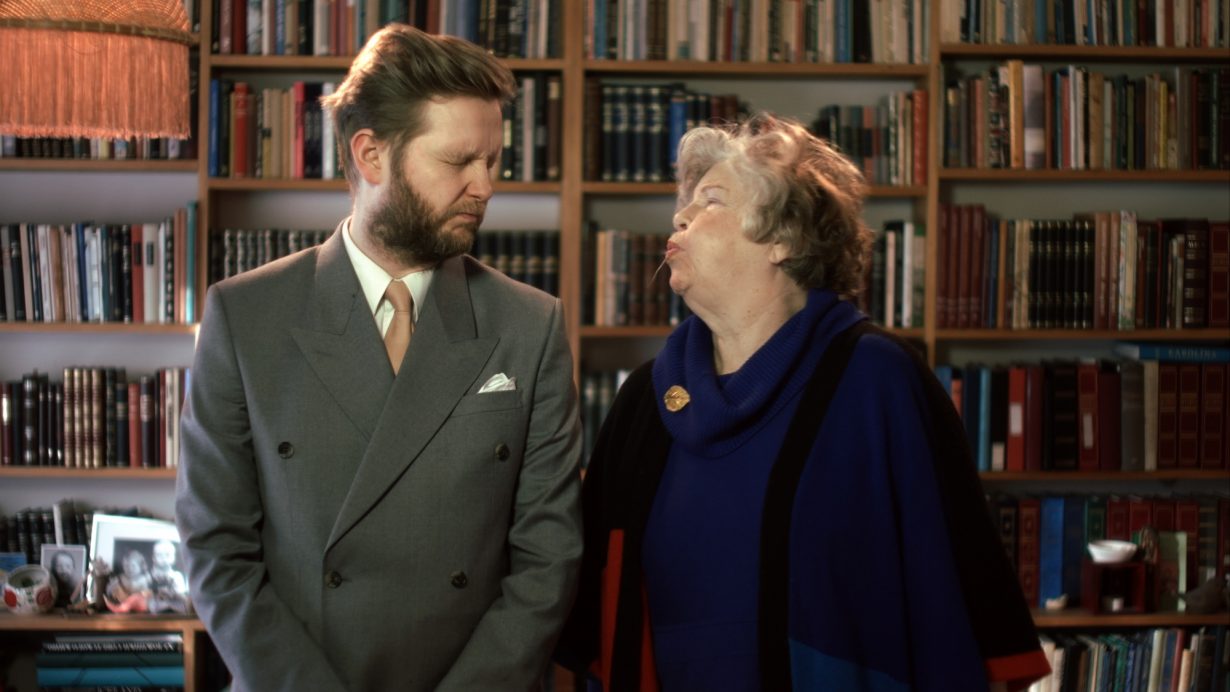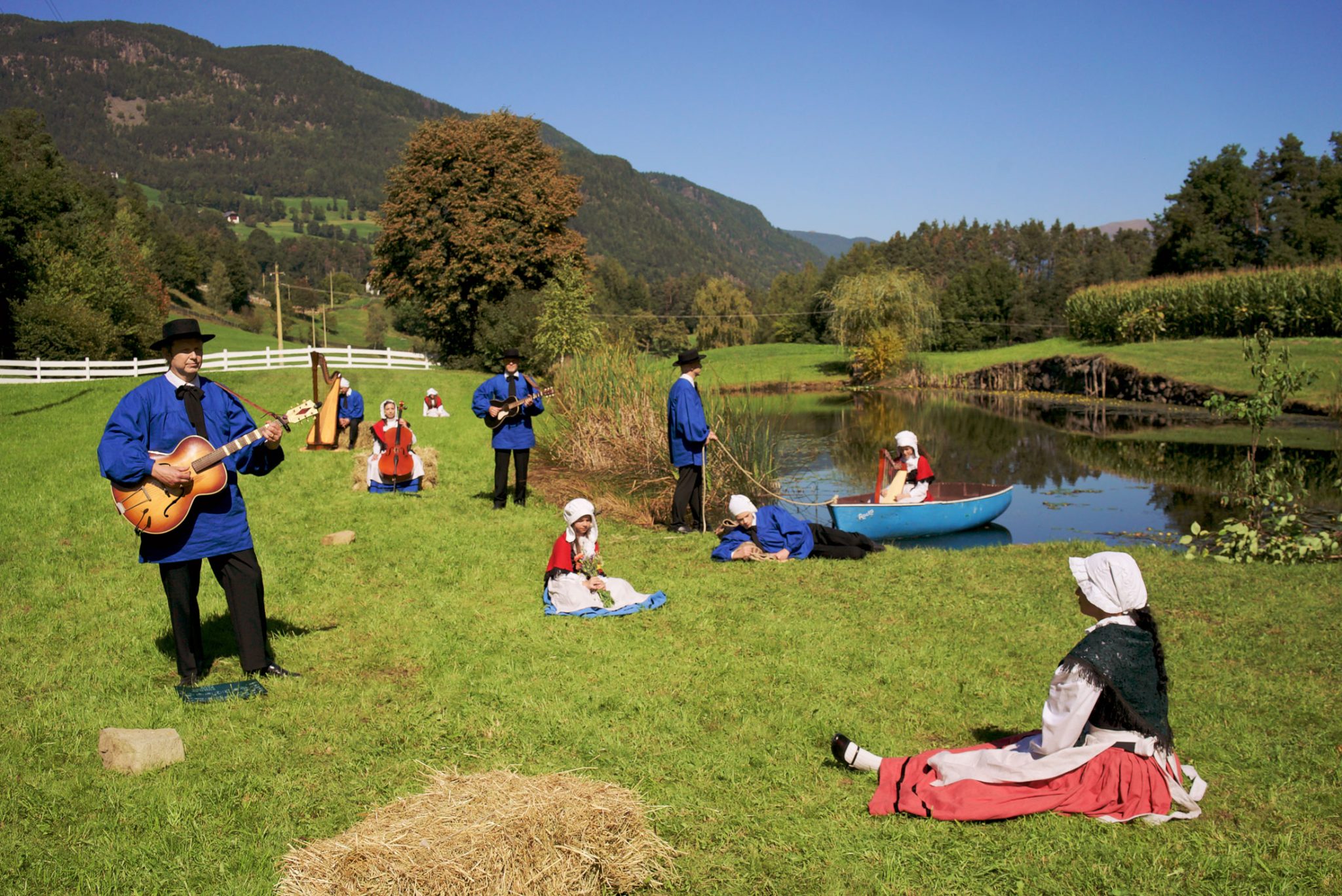Kjartansson’s latest work suggests the impossibility of returning to the past, and therefore captures something unique about recent European politics
Ragnar Kjartansson has done it again, which shouldn’t be a surprise for an artist whose stock in trade is repetition. The celebrated Icelandic performer’s latest video, Sunday Without Love, at Luhring Augustine in New York, reprises his signature musical formula – spare lyrics and harmonies, repeated over and over, to tragicomic effect. Inspired by a souvenir postcard from his daughter’s baptism that the artist keeps on his refrigerator, the nineteen-minute video is set in an idyllic mountain valley. It depicts ten variously aged white people wearing folk costumes of indeterminate European provenance: bonnets, aprons and pink petticoats; top hats, cravats and blue blouses. Half the people play acoustic instruments while the rest loiter on the grass. Kjartansson, the song’s lead vocalist and guitarist, croons an English translation of the short comedic German song ‘Ohne Liebe Leben Lernen’ (1996). Little else transpires.
Yet, like much of Kjartansson’s work, Sunday Without Love does a lot with that little. Inside the gallery, visitors sink into its mood. “You must learn to live,” the song begins, “live without love. / Love is not good for you.” It continues: “Stop all this longing, / looking at stars. / Stay on the ground. / Hear what I say.” That’s the entire song; its un-Romantic message is in tension not only with the video’s distinctly Romantic setting but also the singer’s wistfulness. Despite the pragmatic-minded lyrics Kjartansson sings over and over, his voice conveys a deep sense of longing. It’s as if he were a brooding adolescent, locked in his bedroom, playing the same sad song on repeat. Yet what’s fascinating about the artwork, what takes it beyond mere self-pity, is how it pushes its languid wistfulness to farcical extremes: the setting’s incongruousness, the actors’ folksy cosplay, the lyrics’ insensate repetition. Living without love, the video suggests, doesn’t come at the cost of levity.
Sunday Without Love’s title alludes vaguely to the Christian day of worship. The video’s lush setting appears life-affirming, yet the performers’ anachronistic costumes suggest that the pastoral ideal remains stuck in a mythic past. The costumes’ non-specificity – at the exhibition opening, Kjartansson jokingly described his use of them as “total cultural appropriation… I have no idea what they stand for” – allows them to represent a generalised idea of historical European folk religiosity. While many present-day Europeans, stoked by reactionary politicians and commentators, lament what they perceive to be cultural decline, Sunday Without Love suggests the impossibility of returning to the past, and the ridiculousness of imagining you could, particularly if one reads the repetition of its tragicomic lyrics as a metaphor for cultural stagnation.

Kjartansson has played with the ambiguities of European nostalgia before. For example, his photograph restaging an image taken at the first Russian McDonald’s franchise, Three Sisters (remake of Jay Ranelli’s Lost Photo c. 1990) (2021), contains layers of enigmatic cultural allusion. Kjartansson’s version is based on US theatre director Jay Ranelli’s lost 1990 original, which the latter claims captured three servers with the same names as the lead characters in Anton Chekhov’s play, Three Sisters (1901). The image’s smiling characters and sterile fast-food setting are inversions of Sunday Without Love’s dowdy characters and glorious natural environs, but the dissonance produced by their contrast has a similar effect, making it hard to pin down the artwork’s meaning. Is Three Sisters a heartfelt glance back at the transition to post-Soviet Russia and its increasing openness to Western culture? Is it a commentary on how far Russian culture has fallen, from theatrical masterpieces to the bathos of fast food? Is it an implicit rebuke of Putin-era Russia’s pariah status since its annexation of Crimea? A meta-commentary on the dizzying levels of cultural reference embedded in a photograph that no longer even exists? The artwork’s ambiguities allow it to be all of those things at once: sincere and ironic, impressed and critical, nostalgic and unsentimental.
In Sunday Without Love, the use of a postcard with personal associations as the source text provides a way for Kjartansson to negotiate a similar set of ambiguous feelings. While Sunday Without Love isn’t explicitly about Kjartansson’s daughter in the way that performances such as Me and My Mother (2000-ongoing), or Take Me Here by the Dishwasher: Memorial for a Marriage (2011/14), are about his parents, the artwork can’t help but feel like a knowingly melodramatic lament for the world she was born into – and a past she can never experience. The video has affinities with postcards in that both embrace their own kitschy, stylised nostalgia, which allows irony to coexist with sincerity. Sunday Without Love’s aestheticised blend of ironic performance and sincere expression constitutes Kjartansson’s answer to the bind the song lyrics articulate. Even if living without love might fortify the spirit, why would you want to stop “looking at stars”, dreaming of something better?


It’s as though, on an intellectual level, Kjartansson knows better than to indulge in nostalgia, yet nonetheless recognises its emotional pull for both himself and others. When Clement Greenberg set avant-garde art against commercialised kitsch in his classic essay, ‘Avant-Garde and Kitsch’ (1939), the forces of reaction were at Western Europe’s door and kitsch for him wasn’t merely a matter of bad taste but an instrument of totalitarian demagoguery in Germany, Italy and Russia. Today, the sense of discrete nation-state enemies may be more diffuse, but the perception of a decline in taste, as well as a loss of cultural mooring posts, is even more acute, with the Internet ushering in decades of what the critic Dean Kissick aptly calls ‘Vulgar Images’. Whereas Greenberg believed that only avant-garde art could resist the ‘ersatz culture’ of kitsch, here and elsewhere Kjartansson deflates his own kitschy impulses through an exaggerated embrace of them.
That, too, is something the artist has done many times before, yet both he and his audiences can’t seem to get enough of it. At Sunday Without Love and other installations of his I’ve seen, clumps of visitors linger in front of the glowing screen as though it were a campfire flickering in the dark. In such moments, the audience forms a temporary community in the secular gallery space, the kind of unhurried, reverent gathering that some lament has disappeared with the advent of the smartphone and the decline in attendance at religious services. Longing is like that: you see the thing you wish you had and dwell on it – maybe a bit more than you should. Kjartansson’s irresistible repetitions show us how ridiculously easy it is to get stuck in that feeling but also how sometimes the only way out is through.
Sunday Without Love at Luhring Augustine, Tribeca, through 20 December
Read next How Ragnar Kjartansson’s epic performance works and videos toy with our emotions
